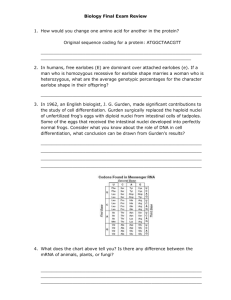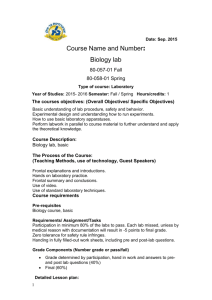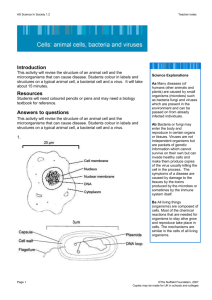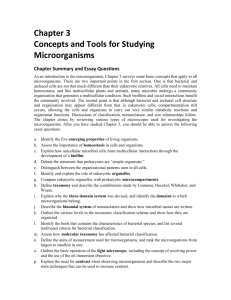Chapter 13 Biology Laboratory Safety The National Association of
advertisement
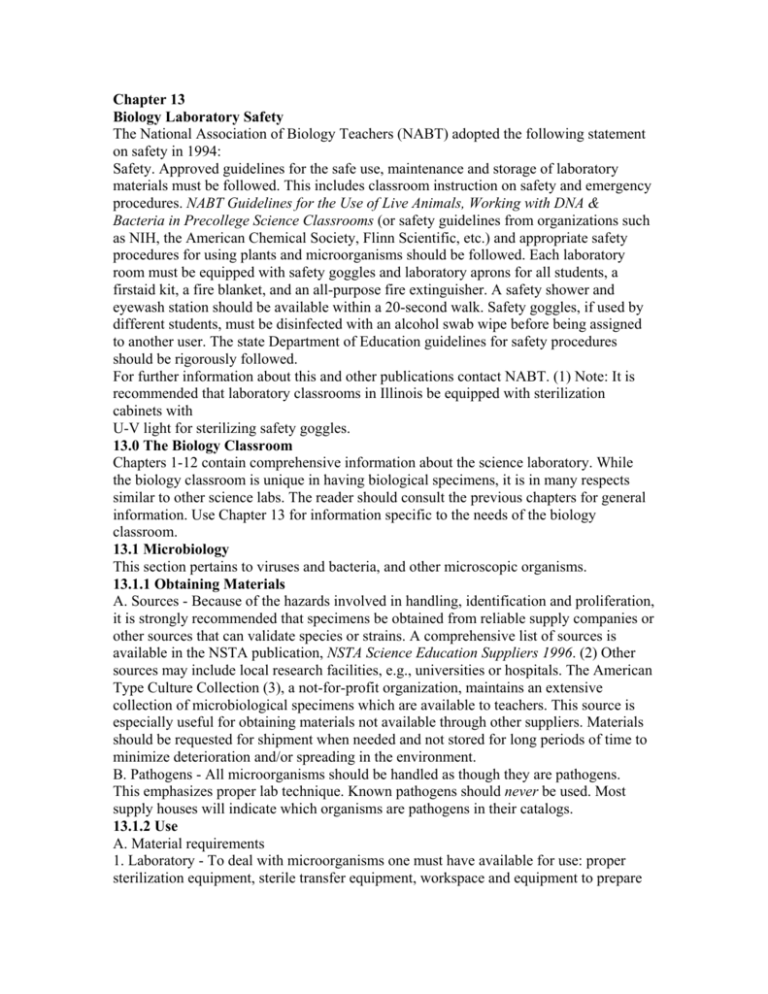
Chapter 13 Biology Laboratory Safety The National Association of Biology Teachers (NABT) adopted the following statement on safety in 1994: Safety. Approved guidelines for the safe use, maintenance and storage of laboratory materials must be followed. This includes classroom instruction on safety and emergency procedures. NABT Guidelines for the Use of Live Animals, Working with DNA & Bacteria in Precollege Science Classrooms (or safety guidelines from organizations such as NIH, the American Chemical Society, Flinn Scientific, etc.) and appropriate safety procedures for using plants and microorganisms should be followed. Each laboratory room must be equipped with safety goggles and laboratory aprons for all students, a firstaid kit, a fire blanket, and an all-purpose fire extinguisher. A safety shower and eyewash station should be available within a 20-second walk. Safety goggles, if used by different students, must be disinfected with an alcohol swab wipe before being assigned to another user. The state Department of Education guidelines for safety procedures should be rigorously followed. For further information about this and other publications contact NABT. (1) Note: It is recommended that laboratory classrooms in Illinois be equipped with sterilization cabinets with U-V light for sterilizing safety goggles. 13.0 The Biology Classroom Chapters 1-12 contain comprehensive information about the science laboratory. While the biology classroom is unique in having biological specimens, it is in many respects similar to other science labs. The reader should consult the previous chapters for general information. Use Chapter 13 for information specific to the needs of the biology classroom. 13.1 Microbiology This section pertains to viruses and bacteria, and other microscopic organisms. 13.1.1 Obtaining Materials A. Sources - Because of the hazards involved in handling, identification and proliferation, it is strongly recommended that specimens be obtained from reliable supply companies or other sources that can validate species or strains. A comprehensive list of sources is available in the NSTA publication, NSTA Science Education Suppliers 1996. (2) Other sources may include local research facilities, e.g., universities or hospitals. The American Type Culture Collection (3), a not-for-profit organization, maintains an extensive collection of microbiological specimens which are available to teachers. This source is especially useful for obtaining materials not available through other suppliers. Materials should be requested for shipment when needed and not stored for long periods of time to minimize deterioration and/or spreading in the environment. B. Pathogens - All microorganisms should be handled as though they are pathogens. This emphasizes proper lab technique. Known pathogens should never be used. Most supply houses will indicate which organisms are pathogens in their catalogs. 13.1.2 Use A. Material requirements 1. Laboratory - To deal with microorganisms one must have available for use: proper sterilization equipment, sterile transfer equipment, workspace and equipment to prepare media, proper storage facilities including refrigeration and incubation equipment, supplies for clean up and disinfecting work areas. Special trash containers should be available for broken glass only. 2. Personal safety - For personal safety common sense dictates that the laboratory be as immaculate as possible. No eating or drinking should be allowed. Air currents should be minimized to avoid contamination. Latex gloves, goggles, and aprons should be used as the teacher deems necessary. Students should be instructed in the use of safety equipment in the classroom. B. Aseptic techniques 1. Area preparation - All work areas should be washed down with disinfectant and allowed to dry before use. This minimizes dust and the chance for accidental contamination. 2. Autoclaving - An autoclave should be available for media preparation, sterilization of glassware and equipment, and for destroying organisms after use. A pressure cooker may be used as a substitute, but it requires greater attention because of the hazards involved in a nonautomatic system. Note: most plastic containers and equipment such as Petri dishes are not autoclavable. 3. Handling - Any time a microorganism is handled, aseptic techniques should be followed. Under no circumstances should mouth pipetting be allowed. a. Disposable equipment - Because of the nature of viruses, only sterile disposable equipment should be used. Although the cost may be higher, it is also recommended for use with other microorganisms. b. Sterilizable equipment - Glassware should be cleaned, then wrapped in newspaper before being placed in the autoclave. Autoclave tape should be used where possible to indicate that the equipment has been properly sterilized. The equipment should remain wrapped until use. Transfer equipment such as wire needles and loops should be flamed in an open flame and then allowed to cool before use. This equipment must be flamed again after use before reuse or storage. 13.1.3 Storage Different experimental materials require special storage techniques. Storage information is provided by suppliers and should be followed. Refrigeration facilities must be available. In order to insure viability and to minimize contamination, do not store microorganisms for long periods of time. Use as soon as possible and destroy after use. 13.1.4 Disposal It is extremely important to dispose of microorganisms properly. They should be destroyed to avoid the possibility of contaminating the environment. Even non-pathogens can upset the micro-ecology of an area. A. Dry Heat Sterilization - Equipment can be placed in an oven at 160-190 degrees Celsius (320-374 degrees F) for 30 minutes. B. Steam Sterilization - Equipment should be autoclaved at 121°C at 15 lbs. pressure for 20 minutes. C. Chemical Sterilization - Commerically available disinfectants or bleach may be used to sterilize working areas and for destroying cultures grown in plastic containers such as disposable Petri plates. 13.2 Botany 13.2.1 Recommendation for Use Plants should be used whenever possible as experimental organisms. 13.2.2 Care Plant care requirements are usually far less demanding than animal care. Facilities necessary include proper lighting, adequate heat, and water and nutrients. Containers should be clean before use. Clay pots should be scrubbed and then soaked in a 10% bleach solution before reuse. This is especially true when experiments are being conducted to avoid contamination factors. Commercial potting mixtures are recommended over garden soil because they are sterile. 13.2.3 Cautions A. Poisonous plants - Certain plants and plant parts as well as fungi contain chemicals which are harmful. Some are poisonous upon skin contact, e.g., poison oak or poison ivy; latex gloves will help to avoid skin contact. Other plants are poisonous when ingested, e.g., foxglove. No plant should be ingested in the biology laboratory. Students should be made aware of poisonous plants and be able to identify any such plants on sight. Contact the local poison control center through the County Health Department or local hospital for specific information regarding procedures to follow. B. Allergic reactions - Teachers should be aware that some students may be allergic to pollen, spores or other airborne plant exudates. Precautions to prevent dispersal should be taken to minimize exposure. C. Other cautions - Many succulents and other plants have thorns or needles. These may be very annoying and even dangerous if contact is made with the skin or eyes. Students should be made aware of the dangers of handling such plants. 13.2.4 Disposal A. Exotic plants - These plants should never be released into the environment where they may compete with local plants. They can severely upset the balance in nature. For example, the kudzu plant and purple loosestrife have become pests of major proportions. B. Native plants - These plants normally should not present a problem for the local environment and should be disposed of in a manner consistent with school policy and local ordinances. 13.3 Zoology 13.3.1 Human Considerations A. Humans as experimental organisms - Non-invasive, nonstressful laboratory activities using students as experimental organisms are encouraged. These include physiological measurements such as, pulse, heart rate, breathing rate, hearing, sight, etc. B. Human body fluids - In recent years, the public has become very concerned about the use of bodily fluids in the classroom. Formerly blood typing and clotting, urinalysis, etc. were done as classroom activities. Most teachers feel that there is too much risk doing these activities. Artificial blood and fluids are available from suppliers. However, students should be encouraged to find out their blood types from their doctors so that this information can be used as data. It is also important that children know their blood types in case of emergency. For information concerning accidental exposure and cleanup see Chapter 6.5. 13.3.2 The use of Animals in Biology Education - NABT Statement The National Association of Biology Teachers (NABT) believes that the study of organisms, including nonhuman animals, is essential to the understanding of life on Earth. NABT recommends the prudent and responsible use of animals in the life science classroom. NABT believes that biology teachers should foster a respect for life. Biology teachers also should teach about the interrelationship and interdependency of all things. Classroom experiences that involve nonhuman animals range from observation to dissection. NABT supports these experiences so long as they are conducted within the long established guidelines of proper care and use of animals, as developed by the scientific and educational community. As with any instructional activity, the use of nonhuman animals in the biology classroom must have sound educational objectives. Any use of animals, whether for observation or dissection, must convey substantive knowledge of biology. NABT believes that biology teachers are in the best position to make this determination for their students. NABT acknowledges that no alternative can substitute for the actual experience of dissection or other use of animals and urges teachers to be aware of the limitations of alternatives. When the teacher determines that the most effective means to meet the objectives of the class do not require dissection, NABT accepts the use of alternatives to dissection including models and various forms of multimedia. The Association encourages teachers to be sensitive to substantive student objections to dissection and to consider providing appropriate lessons for those students where necessary. To implement this policy, NABT endorses and adopts the Principles and Guidelines for the Use of Animals in Precollege Education of the Institute of Laboratory Animals Resources (National Research Council). Copies of this publication may be obtained from NABT or the ILAR. 13.3.3 Living Material (nonhuman) A. Obtaining animals - Under no circumstances should vertebrate animals be taken from the environment. The teacher should use good judgment in obtaining any invertebrate animals from the environment. We recommend that all animals be obtained from authorized suppliers. B. Use 1. Vertebrates - Vertebrate animals should be used only for observational activities and to teach students proper care and handling. No invasive procedures should be done on living vertebrate animals. Such activity is prohibited by the Illinois School Code 105 ILCS 5/ 27-14 which follows: Experiments upon Animals. No experiment upon any living animal for the purpose of demonstration in any study shall be made in any public school. No animal provided by, or killed in the presence of any pupil of a public school shall be used for dissection in such school, and in no case shall dogs or cats be killed for any purposes. Dissection of dead animals, or parts thereof, shall be confined to the classroom and shall not be practiced in the presence of any pupil not engaged in the study to be illustrated thereby. Laivs 1961, p.31, and 27-14, eff. July 1, 1961. 2. Invertebrates - Invertebrate animals are often used for observational and genetic experiments. For example, the fruit fly, Drosophila sp. is used in genetics. Care should be taken to anesthetize organisms properly. If ether is used, it must be stored in an explosion-proof refrigerator. Any anesthetic should be used in a properly ventilated room according to directions given by the supplier. Other methods, such as icing, should be considered as viable alternatives where possible. It is recommended that teachers obtain a manual available from local biological suppliers. These manuals are complete guides for maintaining and studying this organism in the classroom. C. Care - Living organisms have special needs. Requirements for care accompany shipments from reliable sources. Special manuals are available for many organisms. We encourage the purchase and use of these manuals. All animals should be handled gently. They should be given adequate nourishment, water, and ventilation. Cages or other housing should be cleaned regularly. Leather gloves should be worn when handling animals which have the ability to bite or claw. D. Disposal - When the use of the organism is complete, proper disposal is required. Do not release animals into the environment. They may become feral and compete with local fauna. For example, the clawed frog, Xenopus, became a major problem on the west coast where it was released from a lab into the environment. Animals should be euthanized humanely for disposal. 13.3.4 Preserved Materials A. Obtaining 1. Sources - Preserved animals should be ordered from sources which obtain organisms in a humane manner. The source should guarantee to supply properly fixed and preserved specimens. Major biological supply houses (2) make this guarantee. 2. Quantities - Teachers should assess their needs carefully. Only enough material should be ordered to supply one school year. Specimens should not be stored from year to year since deterioration may occur. 3. Preservatives - Specimens are first fixed and then preserved. According to Flinn Scientific, "Fixation is the process which uses a dilute solution of formaldehyde to stabilize proteins and destroy microorganisms. When an animal has been properly fixed, autolysis and microbial breakdown should not occur. Following fixation, various procedures are used by suppliers to transfer specimens into formaldehyde-free preservatives."(5) Formalin is an aqueous solution of formaldehyde. Nonformaldehyde preservatives are generally considered safer for student use. Preserved animals are available that are totally formaldehyde free. These tend to be more expensive. Check with your supplier. Eye protection should be used during dissection activities. Students should be encouraged to wash their hands after handling specimens. Latex gloves should be available for student use. Food should not be allowed in the laboratory. B. Use 1. Dissection Equipment - All equipment must be clean. Scalpels and scissors must be sharp for effective use. Students should be taught to use dissection equipment properly. Dissecting is an activity that requires precise motor skills that must be developed. Students should understand the reason for dissecting. It is an activity that should be treated very seriously. Proper attitudes toward dissection will increase the value of the activity and encourage sensitivity of students toward living things. 2. Dissection Clean-up - Students should be given time to clean tools, pans, and dissecting stations before the end of the lab session. They must also wash their hands thoroughly. If the dissection is to be continued at a later time, specimens should be placed in plastic bags to prevent desication and to aid in identification. When finished with the dissection, all tissues should be disposed of in a common container made available for this purpose. C. Storage - Before use, specimens should be kept in their original containers and placed in an area not available to students. D. Disposal - After checking with local authorities excess preservative fluids should be flushed down the sink with plenty of water. Unused specimens should be placed in a container for disposal in accordance with school policy. 13.4 Biotechnology Many classrooms have introduced hands-on science labs dealing with the topics of molecular biology and biotechnology. Work with DNA is at the core of many of these activities. Spooling, enzymatic digestion, and electrophoresis of this molecule to study its chemical and physical properties, as well as manipulating bacterial cells to introduce new genetic properties, have become commonplace. The Advanced Placement Biology Curriculum Outline (6) recommends lab experiences which include the electrophoresis of DNA and bacterial transformation experiments. Safety, as always, is a crucial part in the performance of these labs. Guidelines for the safe handling of these materials have by now been well established, patterned after practices followed in research laboratories. These include procedures for handling chemicals and microorganisms, maintaining a safe workplace, and the disposal of used materials and cells. The guidelines outlined in 13.4.1 summarize procedures which should be followed when working with biotechnology labs to ensure that the activities will be performed safely. 13.4.1 Handling Microorganisms and DNA in the Laboratory The key to handling any microorganism or DNA molecule in the laboratory is to follow Standard Microbiological Practice as described in the manual, Biosafety in Microbial and Biomedical Laboratories. (7) 1. Handle all microorganisms and DNA carefully; treat them as if they could cause infections. 2. Restrict access to the laboratory during lab periods when microorganisms or DNA are being experimented with (e.g., keep the door closed). 3. Do not eat, drink, or apply cosmetics in the laboratory. Keep fingers and writing instruments away from your face and mouth. 4. Wash your hands with soap and water before and after handling microorganisms and before leaving the laboratory regardless of what materials were used. If you have cuts on your hands or arms, wear latex (or rubber) gloves for protection when handling living materials (e.g., microorganisms). 6. Do not use mouth pipetting for transferring any material; use only mechanical devices. 7. Perform procedures carefully to minimize the formation of aerosols. For example, place pipette tips close to liquid surfaces or near tile bottom of empty receiving containers and discharge fluids down the inner wall of the receiving container. Do not force the last drop from a pipette. Keep pipette tips away from the face to avoid inhaling any aerosol that may be formed. 8. Decontaminate work surfaces before and after the laboratory period and any surface after a spill of living materials. Decontaminating solutions should be readily available and contained in lab squeeze bottles. 9. Dispose of all used solid and liquid materials in specially marked containers. These containers should be easily accessed by students, preferably located at each lab station. 10. Decontaminate all liquid and solid wastes that have been in contact with experimental microorganisms, and kill all experimental microorganisms before disposal. 11. The wearing of protective goggles while working in the laboratory is recommended. 13.4.2 Biogenetic Experimentation A. Organisms - According to NABT's Working with DNA and Bacteria in Precollege Science Classrooms (8), Escherichia coli (E. coli) is the standard experimental bacterium. It is a normal resident of the animal (including human) digestive tract. Many strains of E. coli are known, a few of which can cause significant disease in humans. The laboratory strains commercially available usually do not cause disease. They are designed in such a way that they cannot normally survive outside of the prescribed conditions of the laboratory. However, all of these could cause infection if introduced directly into an open wound or the eye. It is important therefore to adhere strictly to good microbiological practices. Agrobacterium tumefaciens does not cause disease in humans. However, the same precautions for safe handling of microorganisms should be followed. B. Disinfecting and Decontamination - Before carrying out any experiment involving microorganisms, wipe down the laboratory workspace with disinfectant solution. The procedure should be repeated at the end of the lab period as well. Clean up any spills involving microorganisms immediately by disinfecting the spill area thoroughly. Keep disinfectants readily available at work stations in laboratory squeeze bottles. Disinfectant aqueous solutions may be made of 2% commercial disinfectant, 10% bleach, 70% ethanol, and rubbing alcohol. Liquids or solids that have come in contact with living microorganisms, or experimental microorganisms themselves may be decontaminated by steam sterilization. A steam autoclave or pressure cooker set at 121°C., and 15 pounds of pressure, for 20 minutes, will be sufficient to decontaminate or kill living materials. Alternatively, flooding contaminated equipment (e.g., Petri plates) or living materials with 10% bleach solution for one hour will produce the desired effect; pour off the disinfectant solution, disposing of it down the drain. Only glassware that is to be used again need be rinsed with running water. Materials that have come in contact only with DNA or restriction enzymes need not be disinfected. These include pipette tips or other delivery devices, Eppendorf tubes, and electrophoresis gels. C. National Institute of Health Guidelines - The NIH has developed a set of guidelines for conducting research using recombinant molecules and organisms. Over 20 years of experience with this kind of research has led to the conclusion that most experiments are safe to conduct under appropriate conditions and with responsible handling. As a result, many types of experiments have been declared exempt from the guidelines. The usual experiments done in precollege teaching laboratories are of this type. If students wish to pursue research beyond these labs, teachers should make sure that only exempt molecules and microorganisms are used. Refer to NIH Guidelines for Research Involving Recombinant Molecules (9) or contact a local university or research laboratory for advice. D. Staining DNA - Ethidium bromide and methylene blue are the common stains for viewing DNA after electrophoresis. Ethidium bromide is universally used in research labs because it is more sensitive (i.e., can detect minute quantities of DNA) and it is quicker to use. It is, however, a mutagen and a suspected carcinogen. For these reasons, the use of ethidium bromide in the precollege classrooms of Illinois is prohibited. Methylene blue (or a commercial derivative) will also stain DNA; however, it is not as sensitive. Methylene blue is moderately toxic and will stain skin. Latex gloves should be worn when handling this stain. Check local regulations for safe disposal of methylene blue. Do not pour it down the drain without checking with local authorities first. E. Conducting Gel Electrophoresis - Gels are run at high enough electrical voltages, 75-140 volts, to cause severe jolts. Gel boxes should have built-in safety features that interrupt current flow when the cover is removed. Home-built boxes should incorporate this feature. Students should be warned against sticking fingers or other electricityconducting materials (e.g. paper clips, pencils, etc.) into the electrophoresis buffer solution while the gel box is in operation. 13.5 Radiation (see chapter 10) 13.6 Outdoor Education (see chapter 15) 13.7 References 1. NABT Guidelines for the Use of Live Animals, Working with DNA & Bacteria in Precollege Science Classrooms. National Association of Biology Teachers, 11250 Roger Bacon Drive, Reston, VA 22090; (800)406-0775. 2. NSTA Science Education Suppliers 1996. National Science Teachers Association, 1840 Wilson Blvd., Arlington, VA 22201-3000; (703)243-7100. 3. American Type Culture Collection, 2301 Parklawn Drive, Rockville, MD 20852; (301)881-2600. 4. Principals and Guidelines for the Use of Animals in Precollege Education. Institute of Laboratory Animals Resources, 2101 Constitution Avenue, NW, Washington DC 20418; (202)334-2590. 5. Flinn Biological Catalog/Reference Manual, 1996. Flinn Scientific, Inc., 131 Flinn St., P.O. Box 219, Batavia, IL 60510; (800)452-1261. 6. Advanced Placement Biology Curriculum Outline. College Entrance Examination Board and Educational Testing Service, P.O. Box 6670 Princeton, NJ 08541-6670. 7. Biosafety in Microbiological and Biomedical Laboratories. Center for Disease Control and the National Institutes of Health, GPO, Washington, DC 20402. 8. Working with DNA and Bacteria in Precollege Science Classrooms. Toby M. Horn, 1993, National Association of Biology Teachers, 11250 Roger Bacon Drive, Reston, VA 22090; (800)406-0775. 9. NIH Guidelines for Research Involving Recombinant Molecules. National Institute of Health, GPO, Washington, DC 20402.




